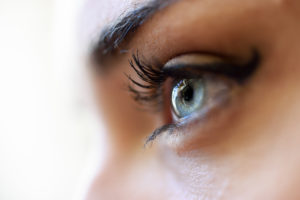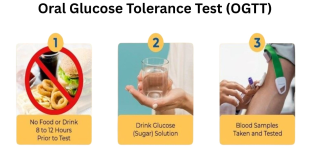
About a quarter of people with Graves’ disease develop thyroid eye disease (TED). TED can happen at any time. It can develop before, during, or after the over-active thyroid disorder is diagnosed, though the two usually come on roughly at the same time. In most cases, the eye disease is mild, but it can be a distressing and disfiguring complication that can be difficult to treat
.
Thyroid eye disease is a chronic autoimmune disorder usually associated with Graves’ disease, although it may also be rarely present in patients with autoimmune hypothyroidism, and in patients who are euthyroid. Patients with TED often suffer with physical discomfort due to pain, grittiness, excessive watering, and photophobia. Periorbital swelling, eyelid retraction, conjunctival redness, proptosis, and squint can cause distressing facial disfigurement. Furthermore, diplopia caused by the involvement of extraocular muscles, and rarely, loss of sight due to corneal scarring or optic nerve compression, may lead to disabling visual impairment.
he physical discomfort, facial disfigurement, and impaired visual function associated with TED could have a major impact on patients’ employment, hobbies, and psychosocial function. Patients with TED are at increased risk of psychological disturbances, such as anxiety and depression, resulting in impaired quality of life. Altered appearance caused by TED seems to be most significant in decreasing quality of life by negatively influencing facial expression, communication, self-perception, and social interactions. However, deficits in visual functioning and the subsequent limitations in daily activities can also contribute
.
These days, many women in Nepal are suffering from thyroid disorder. And, the tragic part is that they are not well informed about the reason of such rampant rise of thyroid problem in recent days. Many medical experts propose that the thyroid hormone tends to be enormously reactive, especially in case of rising levels of other hormones, excluding thyroid stimulating hormones. Why are women nowadays prone to thyroid abnormalities? Among various reasons, one relevant answer can be the ‘birth control pill’. Studies show that mini-pills, or presence of estrogen level in contraceptive pills, cause an upsurge in thyroid and sex hormone binding globulin, besides producing high doses of artificial estrogen and progesterone, and leading to a decline in production of natural hormones (1).
In Nepal, thyroid disorders are among the common endocrine disorders, and may approximate diabetes in prevalence. District hospitals are on the frontline to manage chronic disorders, including thyroid. One of the studies carried out in a district hospital of Nepal shows that the prevalence of thyroid disorder in a district hospital of Nepal was 171 (17.11%) at 95% confidence interval, range occurring from 14 to 20 percent. Among them, 130 (76%) had hypothyroidism, and 41 (24%) had hyperthyroidism. Prevalence of thyroid disorder among females was 147 (14.7%), and among males, 24 (2.4%) (2).
Recent years have witnessed several important initiatives to improve quality of care for patients with TED. To address deficiencies in the quality and parity of care given to patients with TED, the Europian Group of Grave’s Orbitopathy (EUGOGO) has developed evidence-based consensus statement for best practice in the assessment and treatment of TED. The consensus recognizes the value of psychological care, identifies that even mild TED can have a profoundly negative effect on psychosocial functioning, and acknowledges the need for careful assessment of patients’ quality of life (QOL) in order to determine suitable treatment. It also highlights the importance of rehabilitative surgery in eyelids and orbit in patients with inactive TED, and recommends that very long duration of TED is not a contra-indication for rehabilitative surgery. It is found that over one-third of patients with TED remained unhappy with the appearance of their eyes 10 years after treatment, and rehabilitative surgery could be critical in restoring self-esteem and psychosocial functioning in such patients. TED has a negative and lasting impact on QOL and psychosocial function of affected patients (3).
TED affects hundreds of thousands of people in the world. In most cases the eye disease is mild. These are the most common symptoms that require the patient see a doctor.
• Change in the appearance of the eyes (staring or bulging eyes)
• A feeling of grittiness in the eyes or excessive dryness in the eyes
• Watery eyes
• Intolerance of bright lights
• Swelling or feeling of fullness in upper or lower eyelids
• New bags under the eyes
• Redness of the lids and eyes
• Blurred or double vision
• Pain in or behind the eye, especially when looking up, down, or sideways
• Difficulty moving the eyes
TED can affect quality of life. It is well recognized that TED can affect psychological and social well-being. If the patient has fluctuating thyroid levels, he or she may feel anxious, and/or irritable, and suffer from mood swings until the hormone levels are stabilized. Patient may also feel anger, loss of self-esteem or confidence, or socially isolated, because of the change in the appearance of the eyes. Relationships may be affected—both social and at work. This is hardly surprising, as the face and eyes are the most significant point of contact between individuals. TED can change the facial appearance and alter its expression, which may affect the way people react to them, which understandably can be difficult to cope with. Treatment, which may include surgery, can often improve this, and counseling or contact with others who have TED to improve self-esteem.
Early diagnosis of TED is essential for treatment to be effective, and people with TED need to be looked after by a team of ophthalmologist–oculoplastic surgeon specialized in eyelid and orbital diseases and endocrinologist.
Treatments available for people with TED
In mild cases, if the eyes feel gritty, water a lot, and feel uncomfortable in bright lights, artificial tear drops will help the eyes feel more comfortable and help to protect the surface of the eyes. These can be used in the form of drops and gels, and ointments, which last for the longest time.
Although the symptoms may worsen for the first 6 to 18 months or so, after that, the eyes should become stable, or improve. It can take up to two years before the inflammation has gone. Significant inflammation may need treatment with steroids, which can be given orally or intravenously. Steroids can reduce double vision by helping inflamed eye muscles to move more freely. They can also reduce redness and swelling of the eyes and eyelids. In severe cases, steroids can help restore eyesight. Steroid treatments are sometimes combined with other treatments, such as immunosuppressive agents, and/or radiotherapy, for more effective control of the condition and to avoid relapse. Steroids, however, are not very effective in reducing protrusion of the eyes.
Unfortunately, some people with TED are left with permanent double vision or a change in the appearance of their eyes. Rehabilitative surgery may help once the inflammation has settled, including:
• ‘Decompression’ surgery to create more space behind the eyes when there is pressure on the nerve, or if there is a lot of protrusion of the eyeballs, to allow the eyes to close better and to protect the eyes.
• Eye muscle surgery to treat double vision, if this cannot be controlled with prisms.
• Eyelid surgery to protect the eyes and improve the facial appearance.
Cigarette smoking is known to have a major influence on Graves’ disease and on TED. A heavy smoker has the chances of developing TED increased eight times compared to non-smokers. The risk seems to decline very rapidly after quitting. Patients with TED who continue to smoke respond less well to treatments, but this disadvantage seems to disappear soon after giving up smoking.
 Medicosnext
Medicosnext


